I was about twelve when my father bought our first boat. She was an elderly Shetland model open boat of eleven feet keel and about eighteen feet overall, green-painted, with a maroon bottom and inside. Dad chose, for her first "noost", the little round bay at Wester Quarff, and no doubt had in mind the sheltered waters of Clift Sound for our first family outings. However, from the moment she was launched, it became clear that our first voyage was going to be a short one. She leaked like a sieve. With Dad rowing frantically and my brother, sister and I bailing out water industriously, we managed to beach her safely again. The boat was duly put back on her trailer and towed back to our house, where she remained for the rest of that year, a restoration project for my father with what little help he could cajole from the rest of us.
From that time onwards, she was known as the "Hesperus", after the wreck in Henry Wadsworth Longfellow's poem. Dad used an unlikely combination of fibreglass and hardboard to make repairs to her bottom boards and, the following year, now painted white, with a green bottom and cream inside, she was launched again, this time at Clousta on the west side of Shetland. In addition to the repairs to the hull, Dad, clever man that he was, had fixed up a mounting for an outboard motor on the stern, and he had required a Seagull 40+ to propel her along at a steady 5 knots. He had also acquired a mast, boom and standing lug sail, red in colour, to take advantage of any favourable winds we might encounter on our trips. On the shore side of things, an old mangle had, by this time, been commandeered into service as a winch for hauling the boat up. One of its rollers had been removed for this purpose, a hole had been dug for its foundation, and boulders had been piled in to secure it in place during hauling operations. A handle, secured in place with a nail through a hole in the end of the roller, fitted like a sprocket to gear the thing, so that it could be operated by even a weakling like me. My father could do wonderful things with rope, and a couple of blocks and tackle geared the thing down even further.
Many are the trips we made. From Clousta, we sailed and motored out to the fishing grounds out past the cliffs of "da Neean", where we caught a few whiting, haddock and, alas, lots of "Blinnd hoes", as the dogfish is known in Shetland. These were known as a complete pest, dangerous to handle, as they had a poisonous spike, which could cause endless suffering to anyone unfortunate enough to fall foul of it. They are marketed in mainland British restaurants as rock salmon, but to us they had no culinary value, and were thrown back into the sea.
We also explored a great deal around the area, engaging in another of our favourite pastimes of beachcombing. Buoys and floats discarded or lost from fishing boats, bits of wood, rope and net were all collected from beaches around the large, sprawling, and now uninhabited, island of Vementry and the smaller isles of Gruna and Linga. A favourite beach was Suderavoe on Vementry, where we would often brew up and have a picnic. On one occasion we motored further east, across the Swarbacks Minn, to Muckle Roe, where we discovered a sheltered lagoon, full of rocks which took a bit of negotiating and around which shags were diving. We also found a little crevice in the rocky shoreline, shaped almost as if it was a dock specifically made for our boat, where we could step ashore and explore the area. Plants, which I'd never seen growing wild anywhere else, grew in profusion over the rocky ground. I felt a real sense of enchantment about this place, and attempted later to capture the essence of it on canvas (by now, I had discovered the joys of oil painting).
Thus passed the first of many happy Hesperus summers. At the end of it, the boat was put back on her trailer and towed back home to Sandwick, which is towards the south end of Shetland mainland. There she was cleaned and given a lick of paint over the winter months, in preparation for another season of adventure. More of that later.
The Grumpy Old Artist
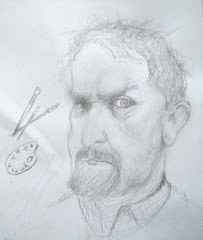
Would YOU pose for this man???
Exhibition Poster

Catterline Event, 2011
Oil Painting by Jim Tait
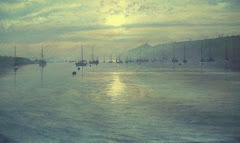
Helford River, Cornwall
Oil Painting by Jim Tait
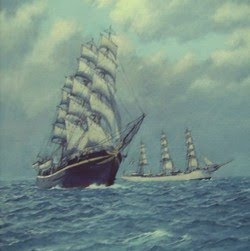
Full-riggers "Georg Stage" and "Danmark"
Other Recent Works
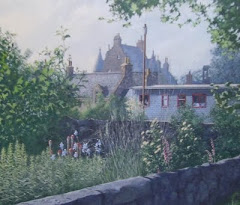
Fordyce Castle and Village

Hay's Dock, Lerwick

Shetland-model Boats at Burravoe, Yell
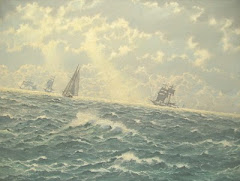
Tall Ships Seascape

The Tour Boat "Dunter III", with Gannets, off Noss
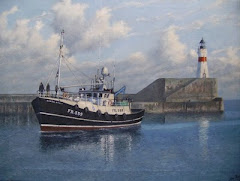
The "Karen Ann II" entering Fraserburgh harbour
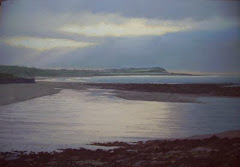
Summer Evening, Boyndie Bay
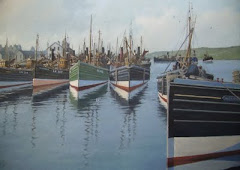
1930s Lerwick Harbour

Johnshaven Harbour
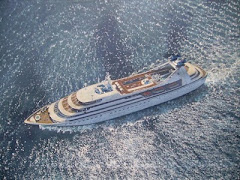
"Seabourn Legend"
Greeting Cards!

Now Available in Packs of Five or in Assorted Sets of Four
Sunday, 15 March 2009
Subscribe to:
Post Comments (Atom)









No comments:
Post a Comment